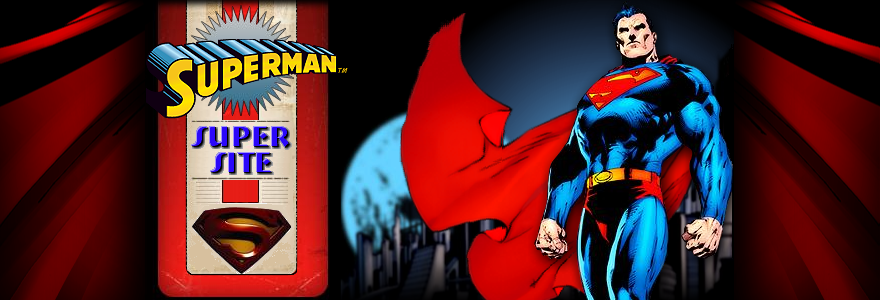You will believe a movie can suck.
Indian Superman is one of those rare movies that manages to offend on every level. It is badly acted, badly directed, badly filmed, and makes no sense whatsoever. And just to add that extra level of offensiveness, the whole project is probably illegal. This Superman is a stone cold rip-off of the 1978 Richard Donner film. It steals story elements, special effects footage, and even music from that far superior film. Because the entire movie is in Hindi with no subtitles, it has taken many hours deciphering its plot. With the help of specially trained translators (okay, a friend who speaks Hindi) and sophisticated Bad Movie Shielding technology (okay, the pause button and lots of root beer), the film has been successfully dissected. Presented now is a detailed synopsis and analysis of this 150-minute monstrosity as proof of our dedication, our courage, our insanity.
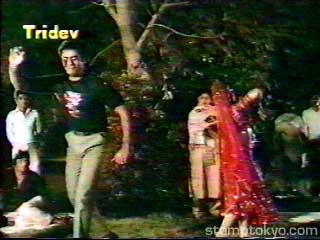 |
Line dancing is a new
art form in India.
|
Our story begins on Krypton with a Jor-El character, played by prolific Indian actor Dharmendra, who tries to convince the planet's ruling council that Krypton will soon be destroyed. When the council refuses to listen, he decides to send his only son to Earth in a baking pan nestled inside a spaceship made of aluminum foil. The rocket takes off (in footage stolen from 1978's Superman, as is nearly all of the special effects footage, along with a good chunk of the music), and the kid lands on Earth, where he is found and adopted by an elderly couple.
What follows is familiar to fans of the Superman legend. The couple names the child Shekhar, and he begins to show signs of super strength. The first of these occurs while his adopted father (played by Ashok Kumar) is watering the garden, and Shekhar bends the hose. This doesn't seem all that super, but it impresses Dad. Later Shekhar lifts his parents' truck when it gets a flat tire. (We don't see the flat tire, however. You know a movie is on the skids when they can't afford to show you a flat tire!)
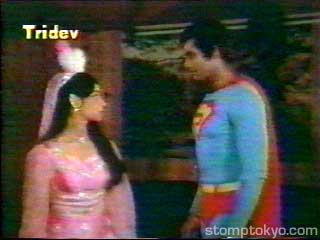 |
"You're supposed to be the
princess from Mario Brothers, right?"
|
A bit later we are treated to scenes at a party, during which little Shekhar begins breakdancing to the Michael Jackson song "Beat It." This brings up a question we were unable to answer: When was this movie made? When faced with things like breakdancing and Michael Jackson songs, one is tempted to think this movie was made in the mid, maybe late 1980s. But Bollywood is a weird place. If you had asked us cold, we would have guessed that Zulmi was made no later than 1990, the appearance of a paperback copy of Mario Puzo's The Last Don aside. So we when we found filmographies for Dharmender that list Superman as being made in 1993, we couldn't totally rule it out. The best information suggests that Superman was released in 1987, probably to capitalize on the success of the Bollywood superhero hit Mr. India.
Shekhar grows up (and is thus played by the grown-up Puneet Issar) and goes to college. He is quite enamored of Gita (Ranjeeta Kour?), another student. But bad guy K. K. Verma (Shakti Kapoor) also has designs on Gita. Of course, he doesn't really have a chance because of Shekhar's super powers. At one point Shekhar is left behind on a school trip, but using his super-speed, Shekhar actually manages to beat Verma and Gita to their destination. Seeing Shekhar there, Verma comments, "There is something black in my lentils."
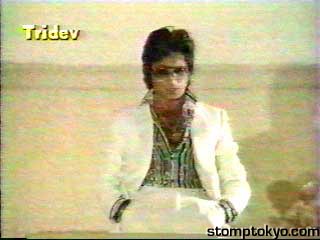 |
"And that was 'Heartbreak Hotel.'
Thank you... thank you very much."
|
The preceding translation comes to us from our friend Jyotika (who, despite her best attempts to hide it, is of Indian descent). She watched the movie with us and gave us the names and as much of the dialogue as we could handle. She also helped us determine some of the fine points of the plot, mainly because we were usually too busy laughing our asses off to figure out what the heck was going on. "Something black in my lentils" is the Hindi idiomatic equivalent of "something fishy is going on," which of course makes perfect sense in context. It's still hilarious in English, though.
Shekhar throws a party at the college to celebrate a visit by his Dad. At the party Dad speaks with Dr. Verma (who may be the father of the younger Verma, but we're not sure), the only other person who knows that Shekhar is adopted. Shekhar uses his super-hearing to eavesdrop and discovers the awful truth, which is probably a story with a moral, but since we don't have super powers we're not sure what it could be. When Shekhar confronts his father with the information, Ashok Kumar seizes the opportunity to get out of this movie and fakes a heart attack. But before leaving the film, Dad tells Shekhar where to find a device that was in the spaceship with Shekhar as a baby. This device looks a lot like a Kryptonian vibrator, but we won't mention that because such jokes are beneath us.
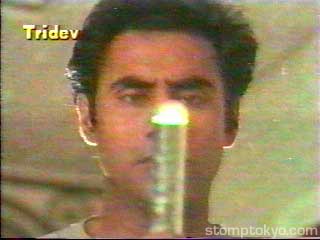 |
"That trip to Times Square
was well worth it!"
|
Shekhar takes the Kryptonian vibrator and, with the assistance of a heaping helping of stock footage, creates the Fortress of Solitude and transforms into Superman. He flies over India, courtesy of more stolen footage and some aerial shots of Bombay. We are also introduced to an odd fish-eyed lens effect that is used to signify Superman flying from time to time. It appears that the camera operator simply placed the camera on a tripod in the middle of Bombay, tilted it up towards the skyline, and spun around a few times. This is supposed to give the illusion of buildings whizzing by when the silhouette of a prone Supes is overlaid on it, but instead gives the incredibly real sensation that you are just on the verge of throwing up.
But hey, we don't really care about Superman and all that flying jazz, right? Instead of showing Superman doing anything, uh, super, the film immediately dumps in a romantic subplot. Shekhar goes to Bombay and looks up Gita, who lives in a hostel for young female professionals and works as a reporter for the local Daily Times. Shekhar shows up at the hostel and, under the guise of looking for Gita, begins peeking in random doors to see what women really do when they're alone. It turns out that they get dressed and slow dance. Shekhar seems fascinated by this, which really makes us scratch our heads. He's Superman! If he's really into this kind of thing, why doesn't he just fly to the Dallas Cowboys Cheerleaders' dressing room and put his X-ray vision to good use?
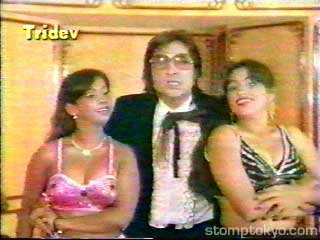 |
"Those 'Buy Real Estate With
No Money Down' programs
really work!"
|
In any case, Shekhar is interrupted in his peeping tom activities by the hostel's den mother. What follows is odious comic relief of the kind familiar to anybody who watches Bollywood or Hong Kong films. A long, predictable conversation ensues, allegedly humorous, but with no punch line. The den mother asks Shekhar what he's doing there. He says he's there to see somebody. She asks if he's there to see woman #1. He says no. She asks if he is there to see woman #2. He says no. "So," she says gleefully, "you must be here to see me!" (Note that we translated all this without the help of Jyotika.) Before things turn ugly Gita shows up, but most Americans will have already hanged themselves from the nearest curtain rod to escape this scene.
Shekhar then tries to get a job at the Daily Times. He goes to the editor's office and tries to convince the man there to give him a job. A long, allegedly humorous conversation follows, but in the end it turns out he is not even the editor! Ha, funny! The real editor is a woman who is not amused by the impostor's antics. Since we never could be bothered to learn the impostor's real name, we'll call him Mr. Odious. He is played by an actor named Jagdeep and he runs through the majority of the film allegedly scoring laughs with his buffoonish behavior. We're sure his style of humor is very popular in certain circles… of Hell!
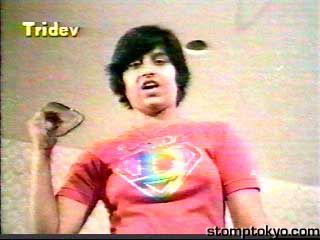 |
"We're the toughest middle school
volleyball team ever!"
|
Shekhar gets the job, and soon he and Gita are partners. But don't think Verma has been idle all this time. By now he's a crime lord, complete with a bunch of lackeys, headed by a white guy named Bob. Bob? All of the names in the world to choose from for a big bald menacing white guy, and they came up with "Bob?" When not smuggling gold, Verma and company kick back and watch a traditional Indian dancing girl. Good thing too, because the movie was starting to go somewhere.
A bit later, we meet Verma's cadre of young female enforcers. No, really. These teenagers wear little white shorts and red T-shirts that have what looks like a stylized "D" on them (no, not their cup size). Verma sends them to kung fu fight members of his organization who betray him. This is a pretty bizarre subplot, considering that the women never clash with Superman.
In an attempt to let Superman do something in the movie, the scene moves to an airplane. Both Gita and Mr. Odious are on it for some reason, so it is naturally hijacked minutes later. But first, wackiness ensues! Mr. Odious needs to go to the bathroom, but it's occupied. Ha! He stands there for a few minutes, his face in positions of anguish as his bladder distends. (We think that was anguish — it's difficult to separate all of Jagdeep's different facial contortions, since they mostly resemble what any one of us looks like after a hammer has been dropped on our foot.) When he is finally released from his watery torture, he is waylaid by an amorous woman who introduces herself, in English, as "Ms. Muscle Woman from Zambia." Hilarious! Kill us!
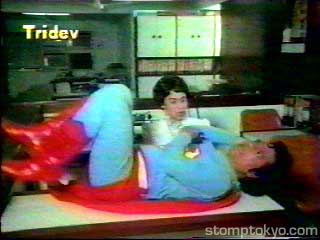 |
|
"Damn red kryptonite!"
|
When the hijacking arrives, it is a great mercy. One of the baddies punches Mr. Odious! Yay! Mr. Odious falls into Ms. Muscle Woman's arms and a full two minutes of "comedy" follows. Boo! Superman saves the day by dragging the plane to an airfield, as represented by shots of a transparent airliner superimposed over aerial shots of Bombay at night, inter-cut with shots of Jor-El casting his arms about. It must have taken a while to get the plane to the airfield -- by the time they land, Bombay's nighttime has become mid-afternoon. Superman then enters the plane, dispenses some poorly edited justice to the terrorists, and the scene ends abruptly without an encounter between Superman and Gita. What the --?
Having failed to establish a romantic rapport between Supes and Gita in the airplane scene, the movie puts Gita and Shekhar together on an assignment to investigate a gold smuggling ring. They follow a car (not any particular car, just a car) and are confronted by thugs on a deserted road. Shekhar tells the thugs he needs to go to the bathroom, and they let him go. Then the thugs attack Gita, and Superman shows up to kick their butts. When Shekhar returns as his civilian identity, Gita asks him what took him so long. His answer (and you can tell this by his hand gestures), is that he had to do "number two."
Verma is disturbed by Superman's interference in his plans, so he sets a trap. Some of his lackeys smuggle some gold (from where to where isn't clear... but then, it never is in Bollywood films). Superman follows them, and when he enters the building, it blows up (in footage from some other film, we'd guess. The fact that it changes from night to day is a bit of a tip-off). Verma then proves that he stayed up all night studying his super-villain playbook by assuming that Superman is dead even though he hasn't seen a body. To celebrate, he throws a party with — you guessed it — dancing girls!
Oh dear God, we're only an hour in.
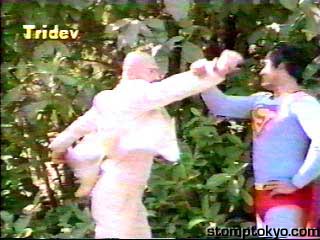 |
Among the greatest of Superman's
enemies is... The Lounge Lizard!
|
Next up comes a completely unrelated scene in which a rich couple decides to give a gift of expensive food to an orphanage. But unbeknownst to the couple, the cruel heads of the institution take the food away and give the children their usual ration of bread. Superman shows up for no reason and, upon discovering the orphans' plight, he uses his telekinetic powers (what!?) to make the good food march out of the basket where it as being kept, dance around a little, then line up in front of the orphans. The stop-motion animation used to achieve the effect of the marching food looks a lot like the animated bits on Sesame Street in the 1970s, but with less technical proficiency. Come to think of it, the orphans probably could have animated this scene more expertly, because they might have actually cared about what they were doing.
Superman performs a few more random acts of Hindu kindness, then calls Gita for a quick chat. At the newspaper office, Gita mentions the call to Mr. Odious, which makes him very jealous. He goes to Shekhar to talk about ways to show up Superman so that he might win Gita for himself. Shekhar, in a bit that recalls that old joke about Clark Kent being a mean drunk, suggests to Mr. Odious that he should become a super villain! Unfortunately, Mr. Odious doesn't fall for this, thus robbing us of the sight of Superman crushing his skull like a grape. Instead Mr. Odious waits until everyone has gone home for the night except Gita, then dresses up in a Superman costume and tries to convince her that he is the Big Blue Boy Scout. The odious comic relief that follows is so odious we refuse to write about it.
Let us pause to reflect for a moment. So far we've seen Superman beat up some thugs, save some orphans from corrupt caretakers, outrun a train, and stand in for a broken tire jack. With the exception of rescuing a hijacked plane, he hasn't done much with his superpowers that wasn't strictly in his own interest. Why, then, are we watching a movie about Superman? Couldn't this be a film about a curly-haired high-school teacher given powers by extraterrestrials? Did the makers of the Indian Superman somehow miss the fact that Superman represents all of the best human characteristics? Why is the name of Superman being sullied thus? For Pete's sake, why isn't he performing altruistic actions worthy of the Man of Steel?
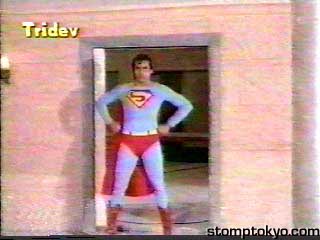 |
Hey, Superman does make a
better door than a window.
|
As if in answer to our pleas the plot, like some sleeping leviathan, kicks in.
At his hideout Verma declares, "I want to be the richest man in the world. And you need money for that." That Verma — he doesn't miss a trick! Armed with a complicated plan that involves depopulating an area of India and selling it to a foreign country, Verma prepares to make the land uninhabitable by setting disasters upon it with a high-tech gadget, which is cleverly disguised as a sound mixing board. Perhaps used to Verma's hare-brained schemes by now, none of his lackeys mention the fact that the unnamed foreign country might not want to buy land that had been destroyed by earthquakes.
Ever mindful of Superman's potential interference with his plans, Verma lures our hero to his lair, where he renders Supes harmless with a bit of Hindu magic involving an amulet. At least, that's the way our highly trained translator explained it to us. What matters is that Supes ends up face down in an Olympic swimming pool with a piece of Mr. T's gold collection around his neck, and must be revived by his personal pep squad (the ghost of his dead father) before he can kick Verma's ass. And in the meantime -- you guessed it -- more dancing girls!
The dancing girls prance about to a victory tune for Verma, which goes something like this:
We haven't lost and we never will
Today you came into our grasp
We are going to kill you
We are going to kill you
By giving you lots of water to drink
We swear, we are not making this up.
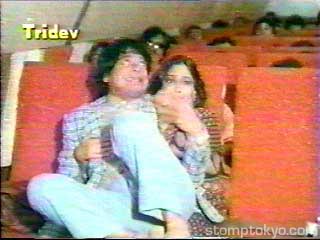 |
Is it me, or are these coach seats
getting smaller?
|
One other point to mention about the dancing girls is that there happens to be a Caucasian dancing girl in the mix. At least, she's dressed like a dancing girl, but apparently she's not good enough to actually dance, because she just sits there and sways her shoulders to the music. So she's more of a sitting girl. We're not sure why she made it into the film (Bob's girlfriend, maybe?), but enough film is wasted on shots of her smiling and swaying that we felt compelled to write about her.
Eventually Superman casts off the evil amulet and springs back into action. Confronting Bob and Verma in their other secret lair, Supes discovers that they have set their plan in motion. The villains' comeuppance must wait until our blue-suited hero can stop the earthquakes, which he does by reversing the flow of time. In the original Superman, this was done to save Lois Lane's life. In this film, it's more of a party trick. Afterwards, Supes rounds up Verma and his gang, handing them off to the police and leaving just enough room for Jagdeep to inflict his Mr. Odious character upon us one last time.
The End.
As you can probably make out through the fuzzy screen captures, the production values on Superman weren't very high. We suspect that more thought was put into the costumes of the dancing girls than was put into selecting the film stock, and it's a sure bet that the script was written after a drunken weekend of watching the original 1978 movie. Every cost-cutting measure possible was taken, from the cheap flying effects to reversing the film when Superman lifts a baddie into the air.
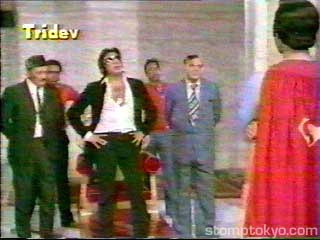 |
The Legion of Doom needs to
do a recruitment drive badly!
|
One thing that can be said for the flick, however, is that the cast seems to be taking the entire enterprise very, very seriously. Kapoor chews the heck out of the scenery in his bad guy scenes while Issar plays Superman completely straight. Faced with the daunting task of bringing a legend to life for the Hindi film-viewing populace, these actors do their utmost to defile the source material in every way imaginable. The only way they could have made it any worse would have been to stuff things down Christopher Reeves' breathing tube.
The concept behind the film, no doubt, was to make the Superman legend a little more palatable to the Indian film going public. They do this by adding elements familiar to the fans of Bollywood films. Bollywood films are pretty surreal all by themselves, so an attempted rip-off of a movie based on a 60-year-old American comic book is going to be odd duck indeed. As per the rules of Bollywood cinema, there are dancing girls every 15 minutes, almost like clockwork. And the almost insufferable altruism of the American Big S has been all but removed completely.
After about an hour of this film, we stopped trying to figure out if D.C. had approved of this project in any way. Clearly, they hadn't. They probably don't even know the film was made. Or maybe they do, and they called in a hit on director B. Gupta and the rest of the crew. That would explain why none of them seem to have any other screen credits we could find with even the most thorough net search. At least we got a little justice, if not the American way.

